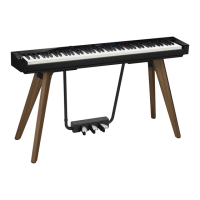
Do you have a question about the Casio Privia PX-S7000 and is the answer not in the manual?
| Touch Sensitivity | 5 sensitivity levels, off |
|---|---|
| Sound Source | Multi-dimensional Morphing AiR Sound Source |
| Polyphony | 256 notes |
| Key Action | Smart Hybrid Hammer Action Keyboard |
| Effects | Reverb, Chorus, DSP, Brilliance |
| Amplifiers | 8W + 8W |
| Bluetooth | Yes (Audio & MIDI) |
| Pedals | 3 (Damper, Soft, Sostenuto) |
| Display | LCD with backlight |
| USB Port | Yes (Type B) |
| Headphone Jack | 2 (Stereo standard) |
| Dimensions | 1340 x 242 x 102 mm (w/o stand, and music stand) |
| Weight | 14.8 kg |
| Included Accessories | Music stand |
| Power Source | AC adapter |
| Number of Tones | 400 built-in tones |
Basic overview of the Digital Piano's front panel, controls, and display.
Instructions for connecting and using the AC adaptor.
How to choose and select individual tones.
How to enable and use Hall Simulator, Reverb, and Surround effects.
How to mix volume, pan, and effects for different parts and inputs.
Core feature for saving current settings as a registration.
Detailed instructions for recording performances using the MIDI recorder.
How to transpose the keyboard pitch in semitone increments.
How to save various piano data (songs, registrations) to a USB drive.
How to set up Bluetooth connections with external devices.
Explains common error messages and their causes/actions.
